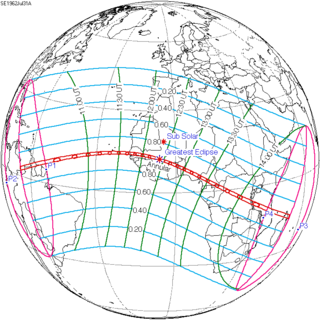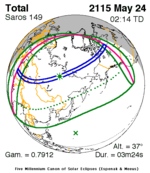| Annular eclipse | |
| Gamma | −0.113 |
|---|---|
| Magnitude | 0.9716 |
| Maximum eclipse | |
| Duration | 213 s (3 min 33 s) |
| Coordinates | 12°00′N5°42′W / 12°N 5.7°W |
| Max. width of band | 103 km (64 mi) |
| Times (UTC) | |
| Greatest eclipse | 12:25:33 |
| References | |
| Saros | 135 (36 of 71) |
| Catalog # (SE5000) | 9425 |
An annular solar eclipse occurred at the Moon's ascending node of orbit on Tuesday, July 31, 1962, [1] with a magnitude of 0.9716. A solar eclipse occurs when the Moon passes between Earth and the Sun, thereby totally or partly obscuring the image of the Sun for a viewer on Earth. An annular solar eclipse occurs when the Moon's apparent diameter is smaller than the Sun's, blocking most of the Sun's light and causing the Sun to look like an annulus (ring). An annular eclipse appears as a partial eclipse over a region of the Earth thousands of kilometres wide. Occurring about 4.75 days before apogee (on August 5, 1962, at 6:40 UTC), the Moon's apparent diameter was smaller. [2]
Contents
- Eclipse details
- Eclipse season
- Related eclipses
- Eclipses in 1962
- Metonic
- Tzolkinex
- Half-Saros
- Tritos
- Solar Saros 135
- Inex
- Triad
- Solar eclipses of 1961–1964
- Saros 135
- Metonic series
- Tritos series
- Inex series
- Notes
- References
Places inside the annular eclipse included Venezuela, northern Roraima in Brazil, British Guiana (today's Guyana), Dutch Guiana (today's Suriname) including the capital city Paramaribo, Senegal, Gambia Colony and Protectorate (today's Gambia) including the southern part of the capital city Banjul, Mali including the capital city Bamako, Upper Volta (today's Burkina Faso), Ghana, Togo, Dahomey (today's Benin), Nigeria, Cameroon including the capital city Yaoundé, Congo-Brazzaville, Congo-Léopoldville (today's DR Congo), Tanganyika (now belonging to Tanzania), northeastern tip of Portuguese Mozambique (today's Mozambique), French Comoros (today's Comoros), Mayotte, and the Malagasy Republic (today's Madagascar). The greatest eclipse was in the area of Kouoro, Mali at 12 N, 5.7 W at 12:25 (UTC) and lasted for 3 minutes. [3] A partial eclipse was visible for parts of the Caribbean, northern South America, Africa, Southern Europe, and the Middle East.









































































































